Chapter 4 - Life Expectancy
Although mortality rates in Scotland have generally fallen more slowly than in the rest of the UK and elsewhere in Europe, the improvements are still considerable and the impact is reflected in the steadily rising expectation of life.
The expectation of life at birth is a commonly used measure of mortality which is particularly helpful in comparing the ‘health’ of a nation through time and for making comparisons with other countries as well as for areas within Scotland. Figure 4.1 shows that the expectation of life at birth in Scotland has improved greatly over the last 25 years or so, increasing from 69.1 years for men and 75.3 years for women born around 1981 to 75.8 years and 80.3 years respectively for those born around 2009. Figure 4.1 also illustrates that improvements in life expectancy at birth are projected to continue, rising to 80.7 years for men and 85.2 years for women by 2033.
Figure 4.1 Expectation of life at birth, Scotland, 1981-20331
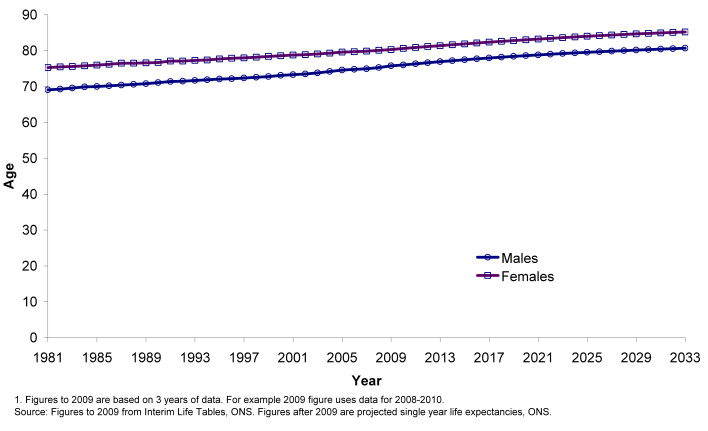
However, Figures 4.2a and 4.2b show that Scottish men and women have relatively low expectation of life at birth compared with much of the European Union. The countries with lower life expectancy than Scotland were most of the Eastern European states which joined the EU on 1 May 2004 as well as Romania and Bulgaria which joined in January 2007. For men, the expectation of life in Scotland is about 4 years lower than the countries with the highest expectation of life whilst for women it is almost 5 years lower.
Figure 4.2a Life expectancy at birth, 2008, selected countries, Males
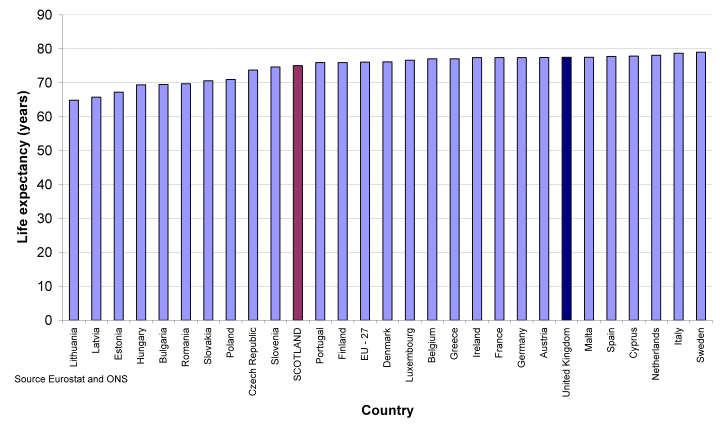
Figure 4.2b Life expectancy at birth, 2008, selected countries, Females
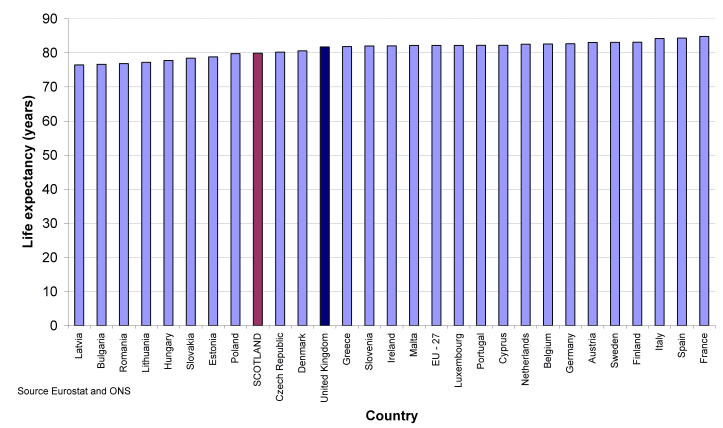
Within Scotland, there are considerable differences in life expectancy at birth between different Council areas as illustrated in Figure 4.3. For men, the Council area with the lowest life expectancy was Glasgow City (71.1 years), and the Council area with the highest life expectancy was East Dunbartonshire (78.3 years), 7.2 years more than Glasgow City. For women, East Dunbartonshire also had the highest life expectancy (83.1 years), 5.6 years more than Glasgow City, the area with the lowest figure (77.5 years).
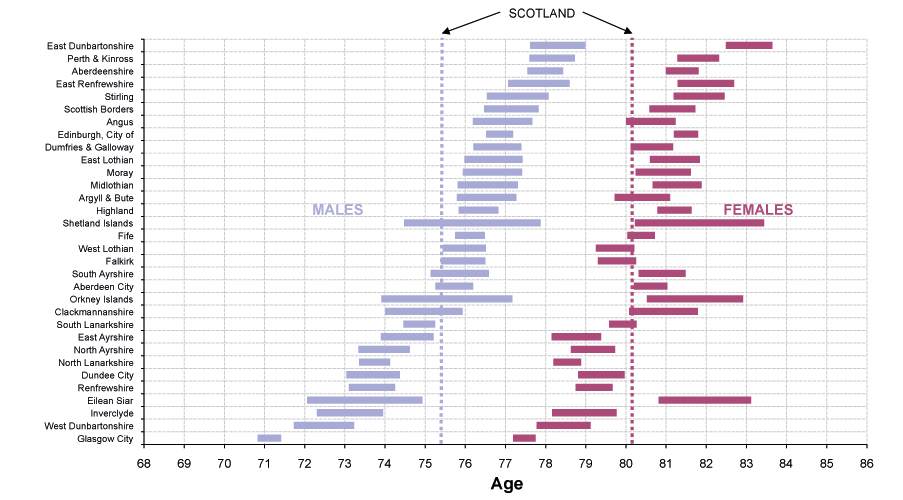
1. Life expectancy at birth is an estimate which is subject to a margin of error. The accuracy of results can be indicated by calculating a confidence interval which provides a range within which the true value of underlying life expectancy would lie (with 95 per cent probability).
Please note that the Scotland-level life expectancy estimate shown in this chart is for use only as a comparator for the corresponding sub-Scotland-level figures. The definitive Scotland-level life expectancy estimate (based on interim life tables) is published by the Office for National Statistics.
There are also differences between urban and rural areas as shown in Figure 4.4. Men in rural areas – remote and accessible – can expect to live just over 3.5 years longer (77.6 and 77.9 years respectively) than men in large urban areas (74.0 years). Women in rural areas – remote and accessible – can expect to live around 2 years longer (81.8 and 81.5 years respectively) than women in large urban areas (79.5 years).
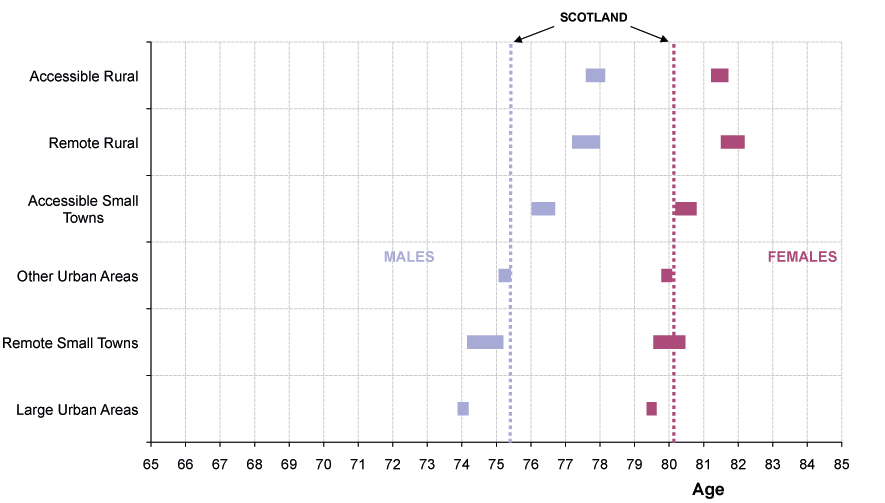
1. Life expectancy at birth is an estimate which is subject to a margin of error. The accuracy of results can be indicated by calculating a confidence interval which provides a range within which the true value of underlying life expectancy would lie (with 95 per cent probability).
2. Scottish Government’s 6-fold Urban Rural Classification version 2009-2010. See Appendix 2 for more details.
Please note that the Scotland-level life expectancy estimate shown in this chart is for use only as a comparator for the corresponding sub-Scotland-level figures. The definitive Scotland-level life expectancy estimate (based on interim life tables) is published by the Office for National Statistics.
A more detailed picture of the large geographical variations in life expectancy can be seen in the 40 Scottish Community Health Partnership (CHP) areas*. The principal aim of the CHPs, which link NHS and Council services, is to improve the long-term health and wellbeing of communities and enhance the quality of health and social care services. Life expectancy at birth in the 40 CHP areas is shown in Figure 4.5. Men in East Dunbartonshire CHP area can expect to live over 8 years longer than men in North and East Glasgow CHP areas (78.3 years compared with 69.8 and 70.1 years respectively). Women in East Dunbartonshire CHP area can expect to live around 6 years longer than women in North and East Glasgow CHP areas (83.1 years compared with 76.2 and 77.3 years respectively).
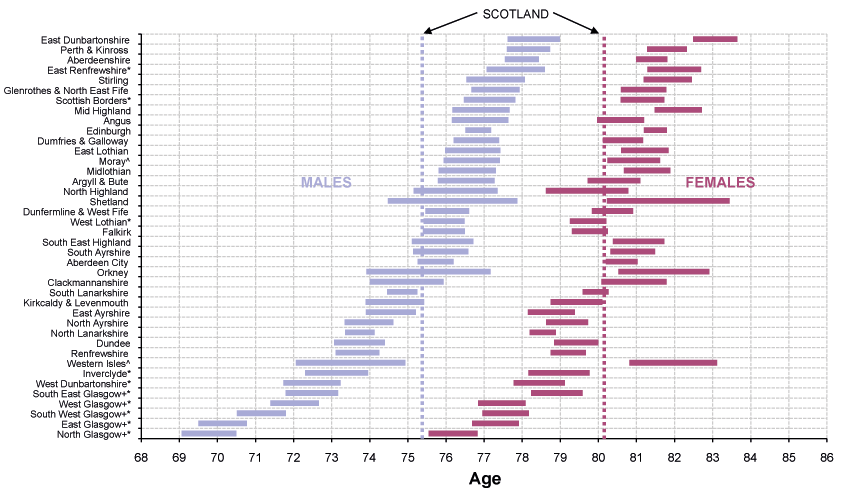
*Known as a Community Health and Care Partnership
^Known as a Community Health and Social Care Partnership
+Glasgow CHPs are based on five Community Health and Care Partnerships which existed before the new single CHP was set up on 22 March 2011
1. Life expectancy at birth is an estimate which is subject to a margin of error. The accuracy of results can be indicated by calculating a confidence interval which provides a range within which the true value of underlying life expectancy would lie (with 95 per cent probability).
Please note that the Scotland-level life expectancy estimate shown in this chart is for use only as a comparator for the corresponding sub-Scotland-level figures. The definitive Scotland-level life expectancy estimate (based on interim life tables) is published by the Office for National Statistics.
The percentage change in life expectancy at birth in CHP areas over the 10 year period 1997-1999 to 2007-2009 is illustrated in Figures 4.6a and 4.6b (ordered from left to right by lowest to highest life expectancy in 1997-1999). The improvement at the national level over the 10 year period was 3.8 per cent for men (or 2.7 years) and 2.5 per cent for females (or 2.0 years) and is shown by the heavy horizontal lines across the charts.
In the 10 years since 1997-1999, life expectancy at birth has increased in every CHP area, although in 7 cases by a margin so small that it may be a consequence of the volatile nature of life expectancy estimates in small areas. For men, the largest increase in life expectancy at birth was in Mid Highland with 6.2 per cent (an improvement of 4.5 years) and for women in East Dunbartonshire with 4.5 per cent (an improvement of 3.6 years). The gap of 9.3 years between the area with the highest male life expectancy at birth and the area with the lowest has decreased by 0.8 years over the 10 year period; for females it has increased by 0.6 years (from 6.3 years in 1997-1999 to 6.9 years in 2007-2009). The gap between male and female life expectancy narrowed in all but 7 of the CHP areas. The gap decreased most in North Highland (3.5 years in 2007-2009 compared with 6.0 years in 1997-1999).
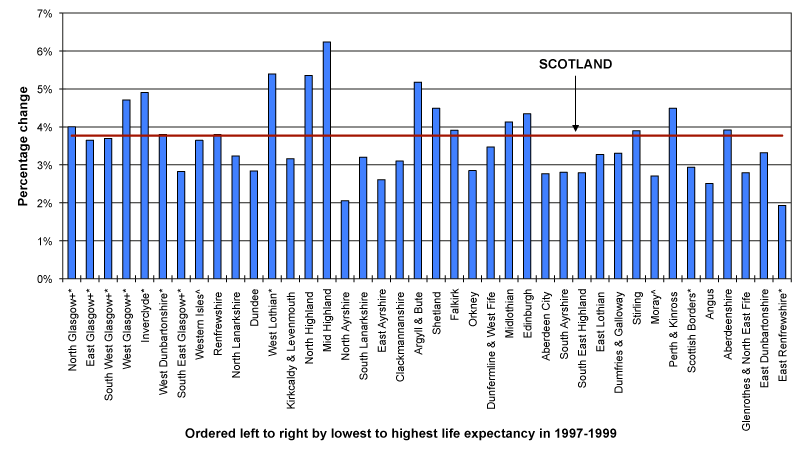
*Known as a Community Health and Care Partnership
^Known as a Community Health and Social Care Partnership
+Glasgow CHPs are based on five Community Health and Care Partnerships which existed before the new single CHP was set up on 22 March 2011
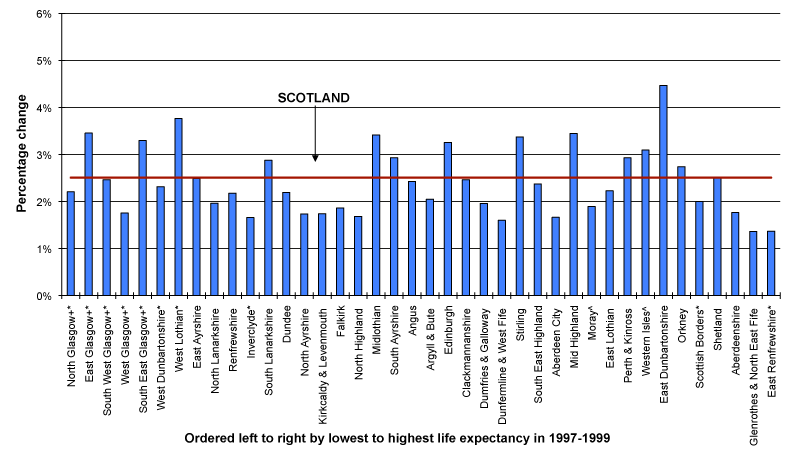
*Known as a Community Health and Care Partnership
^Known as a Community Health and Social Care Partnership
+Glasgow CHPs are based on five Community Health and Care Partnerships which existed before the new single CHP was set up on 22 March 2011
In West Glasgow and Inverclyde CHPs (areas which had among the lowest life expectancy at birth in 1997-1999), male life expectancy improved by 4.7 and 4.9 per cent respectively (or 3.2 and 3.4 years) over the last 10 years which is around 1 percentage point more than the average improvement experienced by Scotland. In contrast, life expectancy at birth for men in North Glasgow, East Glasgow and South West Glasgow CHPs (the areas ranked lowest to third lowest respectively in 1997-1999) improved but at around the average rate of improvement for Scotland. In South East Glasgow CHP, life expectancy started out low 10 years ago and only improved marginally over the period.
The largest improvement in female life expectancy between 1997-1999 and 2007-2009 was in East Dunbartonshire CHP area (4.5 per cent or 3.6 years), which was also among the best performing in terms of life expectancy in 1997-1999. Female life expectancy in Mid Highland and Stirling CHP areas behave in a similar way to East Dunbartonshire in that these CHP areas had a higher life expectancy than the national average in 1997-1999, and have improved at a much greater rate than the Scottish average. There are areas where female life expectations improved at a better rate than average for Scotland and had a very low life expectancy in 1997-1999 – for example East Glasgow, South East Glasgow and West Lothian CHP areas. These areas have improved by 3.3 per cent to 3.8 per cent, but there does not seem to be a pattern whereby all of the best performing areas in 1997-1999 have pulled further ahead.
Life expectancy decreases as deprivation increases, as illustrated by Figure 4.7. Men in the 10 per cent least deprived areas of Scotland can expect to live around 13.4 years longer than those in the 10 per cent most deprived areas (81.1 years compared with 67.7 years). Women in the 10 per cent least deprived areas of Scotland can expect to live around 9 years longer than those in the 10 per cent most deprived areas (84.4 years compared with 75.4 years).
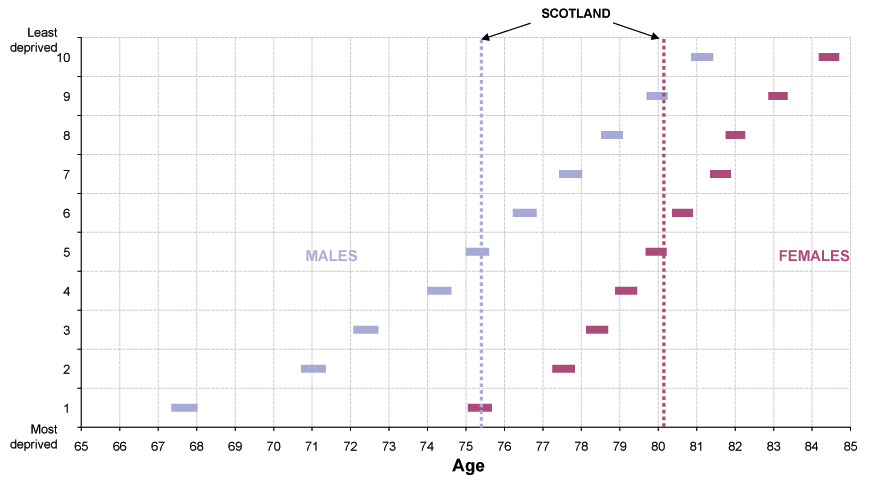
1. Life expectancy at birth is an estimate which is subject to a margin of error. The accuracy of results can be indicated by calculating a confidence interval which provides a range within which the true value of underlying life expectancy would lie (with 95 per cent probability).
2. Scottish Index of Multiple Deprivation (SIMD) 2009. For more information see Appendix 2.
Please note that the Scotland-level life expectancy estimate shown in this chart is for use only as a comparator for the corresponding sub-Scotland-level figures. The definitive Scotland-level life expectancy estimate (based on interim life tables) is published by the Office for National Statistics.
A useful extension of life expectancy estimates is information on Healthy Life Expectancy (HLE) which is published by the Information and Statistics Division of the NHS. HLE is defined as the number of years people can expect to live in good health. The difference between HLE and life expectancy indicates the length of time people can expect to spend in poor health. More information on HLE in Scotland is available on the website of the Scottish Public Health Observatory (ScotPHO): www.scotpho.org.uk
More information about life expectancy statistics
More detailed information about Scotland’s life expectancy can be found at: http://www.nrscotland.gov.uk/statistics-and-data/statistics/statistics-by-theme/life-expectancy